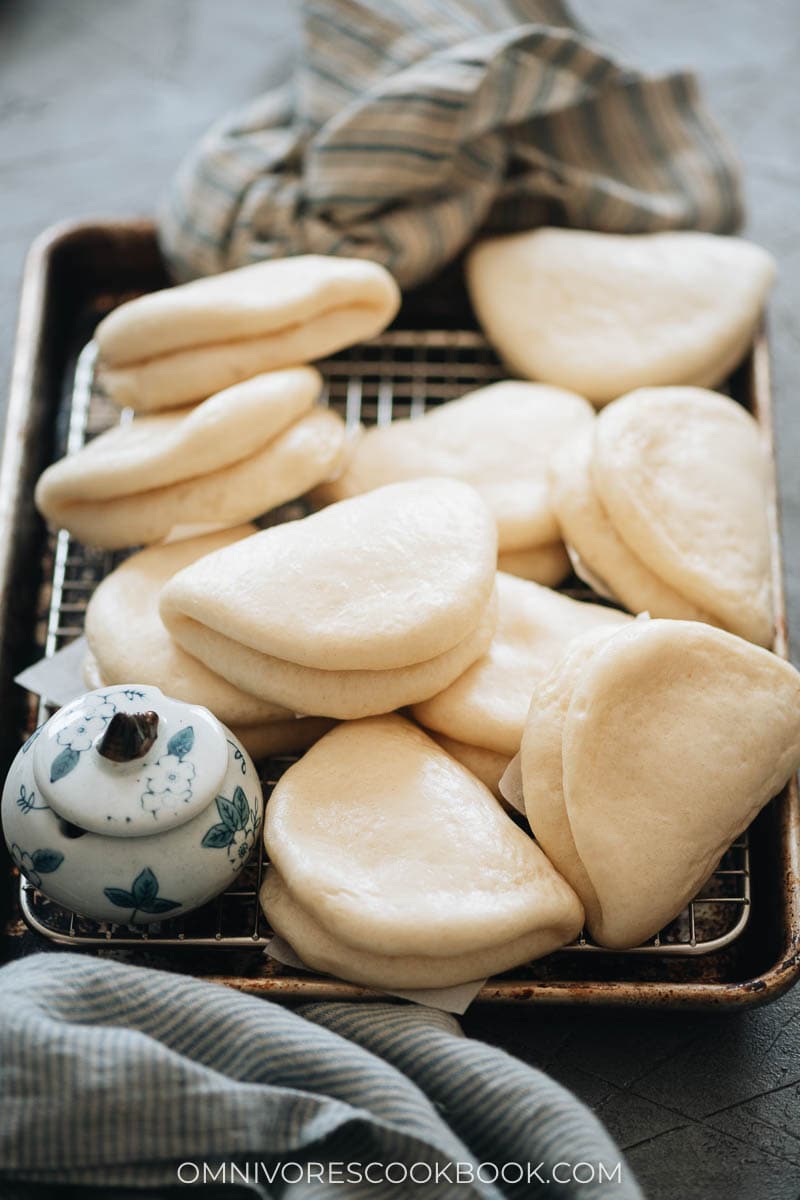
Bao buns are such a great thing to have around. I personally love making Gua Bao, and that’s where these bao buns come in. They are the essential ingredient for making gua bao, though plenty of other goodies can be stuffed into these buns.
I love serving moo shu chicken and braised beef in the bao buns. You can get really creative with the fillings. For example, stuff the buns with Chinese fried pork chops and hot sauce to create a fancy restaurant-style sandwich.
The light, fluffy texture of the bao buns comes from steaming them. Since they’re made from such simple ingredients, you should already have everything you need to make them in your pantry.
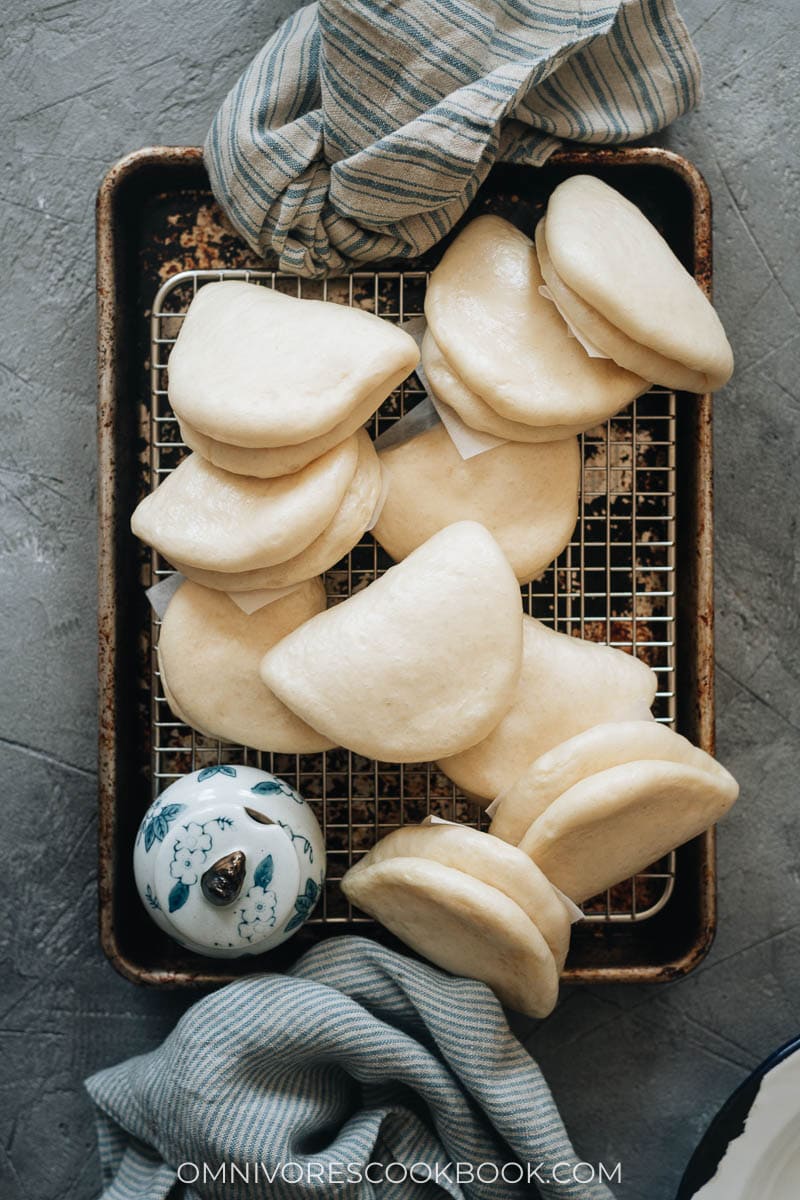
Bao Buns cooking process
However, despite the simplicity of the ingredients, the process of making steamed bao buns can be a bit tricky. That’s why, when you look below, you’ll see I’ve prepared super-detailed step-by-step instructions, complete with photos and a video, so you’ll feel like I’m with you in your kitchen making these bao buns. I’ve also attached notes for troubleshooting below.
Part 1 – prepare the dough & 1st rise
- Combine all the dry ingredients in a mixing bowl
- Add the wet ingredients
- Knead the dough with a mixer (this step can easily be done by hand, as well)
- Cover the dough and let it rest for 10 minutes
- Knead the dough for a minute
- Let the dough rest again for about 1 hour
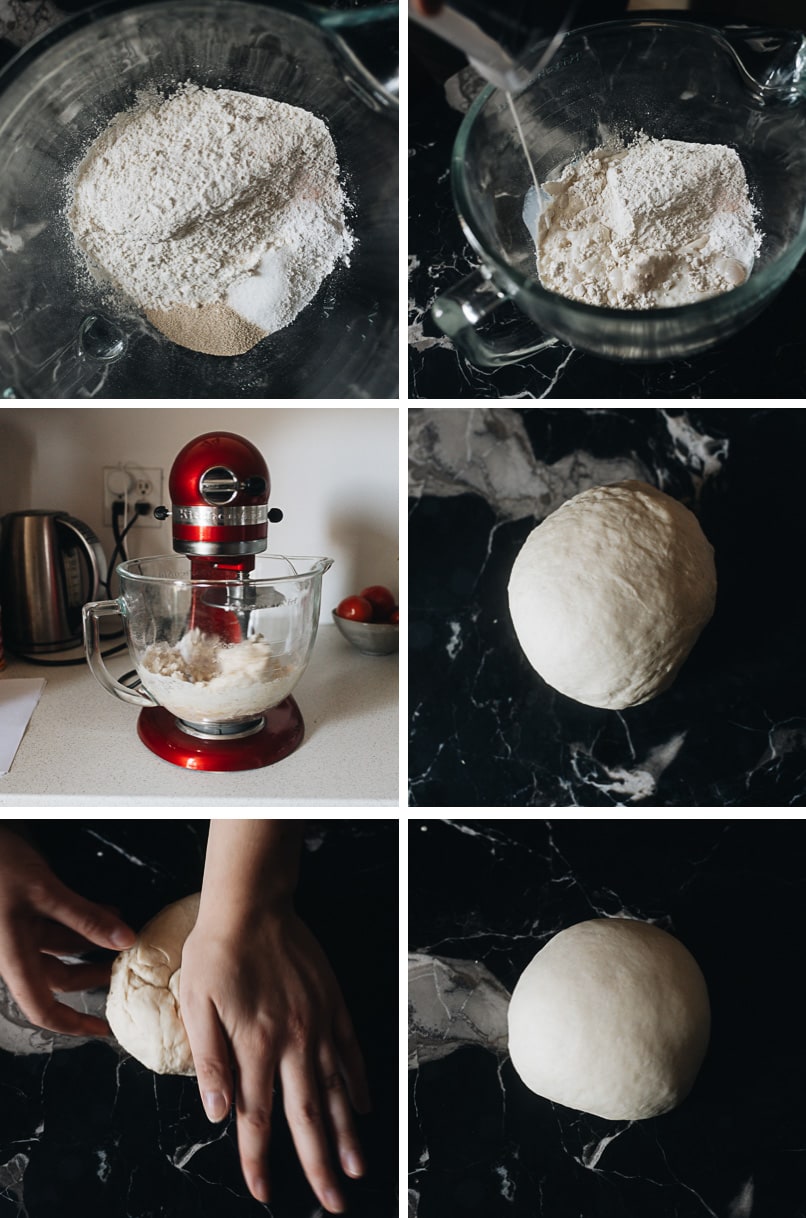
Part 2 – divide the dough
- The dough is ready after the size has doubled
- Gently knead the dough one more time
- Cut the dough into even pieces
- Pull the dough together into a ball
- Roll the dough to further form it into a dough ball
- Always cover the dough with plastic wrap when working on the rest of the dough
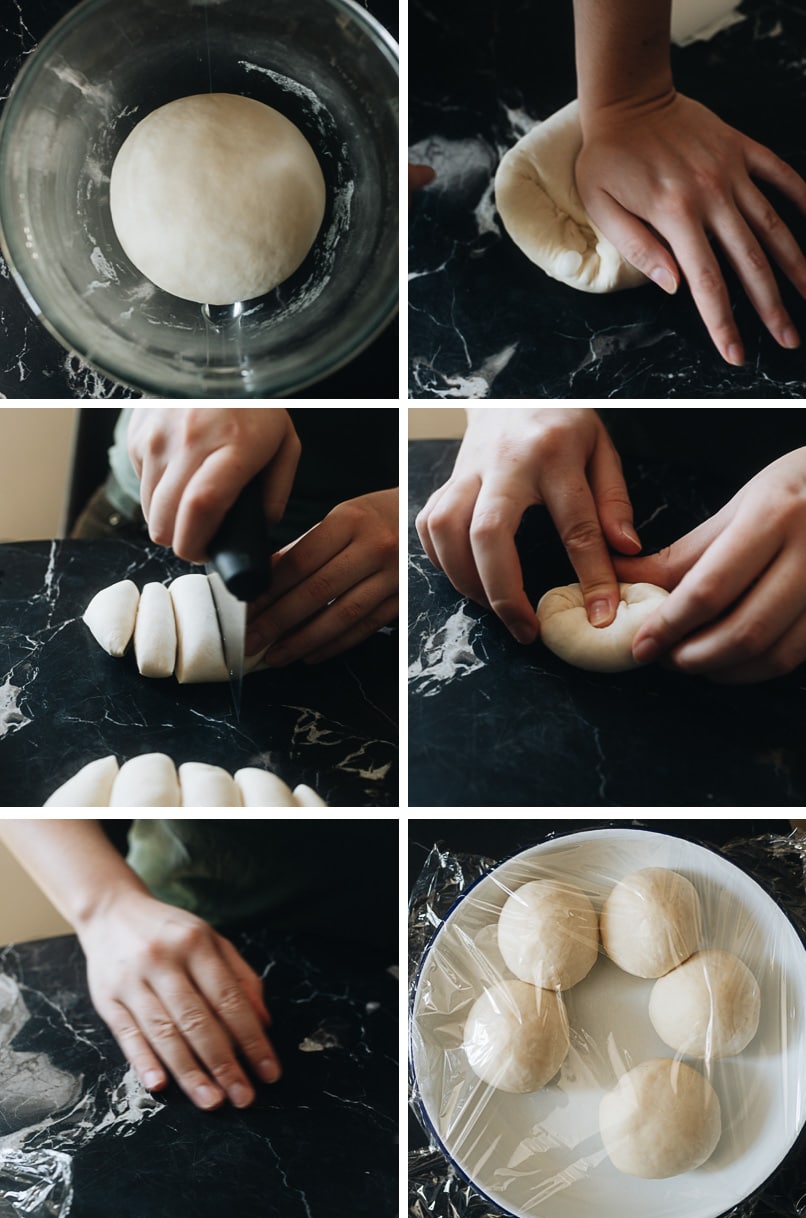
Part 3 – form the buns, 2nd rise & cook
- Roll each dough ball out into a long oval piece
- Brush oil onto it (so the bun will separate easily later)
- Fold the oval dough to shape the bun
- Place it on a piece of parchment paper
- Let the buns rise again before cooking
- Lay some towels under the lid if you’re using a metal steamer, to prevent the water from dripping onto the buns
- Steam the buns, then rest them, covered with the lid, before serving
- You can serve the buns immediately or store them for later use
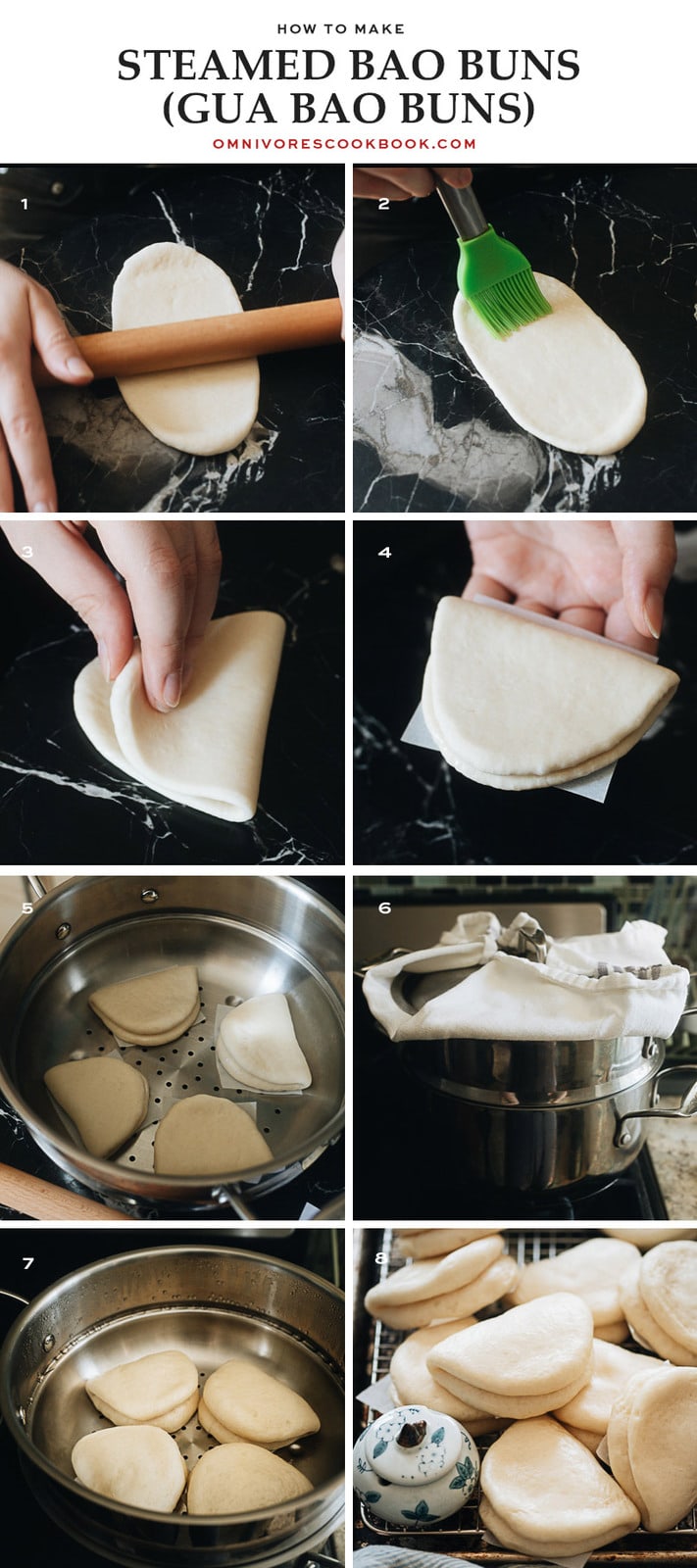
The keys to making bao buns and troubleshooting
Some parts of the buns have brown and yellow spots after steaming and the texture is chewy
This is a very common issue for steamed buns and it’s usually caused by a sudden increase and/or decrease in pressure while steaming. To avoid it, you should:
- Slowly heat up the bun dough in the steamer. Do not boil the water in the steamer and add the steaming rack directly. Instead, place the steamer over the water, then start cooking. So the temperature of the steamer rack will rise gradually.
- Use medium or medium-low heat during steaming. High heat and rapid steam might also cause the buns to scorch.
- Rest the buns without lifting the cover for at least 10 minutes after cooking. This is very important. So the pressure in the steamer will drop gradually.
The buns deflate after steaming
This is usually caused by over-proofing. If the dough has risen too far, it will expand then collapse during cooking.
The tricky thing is, the proofing time can vary quite a lot depending on your environment and the ingredients you use (e.g. how fresh your yeast is). Our recipe uses instant yeast instead of active dry yeast to prevent this issue. However, you will still need to keep an eye on the dough and use your judgement and experience to decide if the dough has risen enough.
For the 2nd rise, if you’re taking time to shape and prepare the dough, you can store the rest of the dough covered in the fridge to prevent over-proofing.
The buns have expanded too much and look weird
This issue can also be caused by over-proofing. The buns will come out extra fluffy and this doesn’t affect the taste, but they will not look as pretty. You can refer to the above paragraph for the solution.
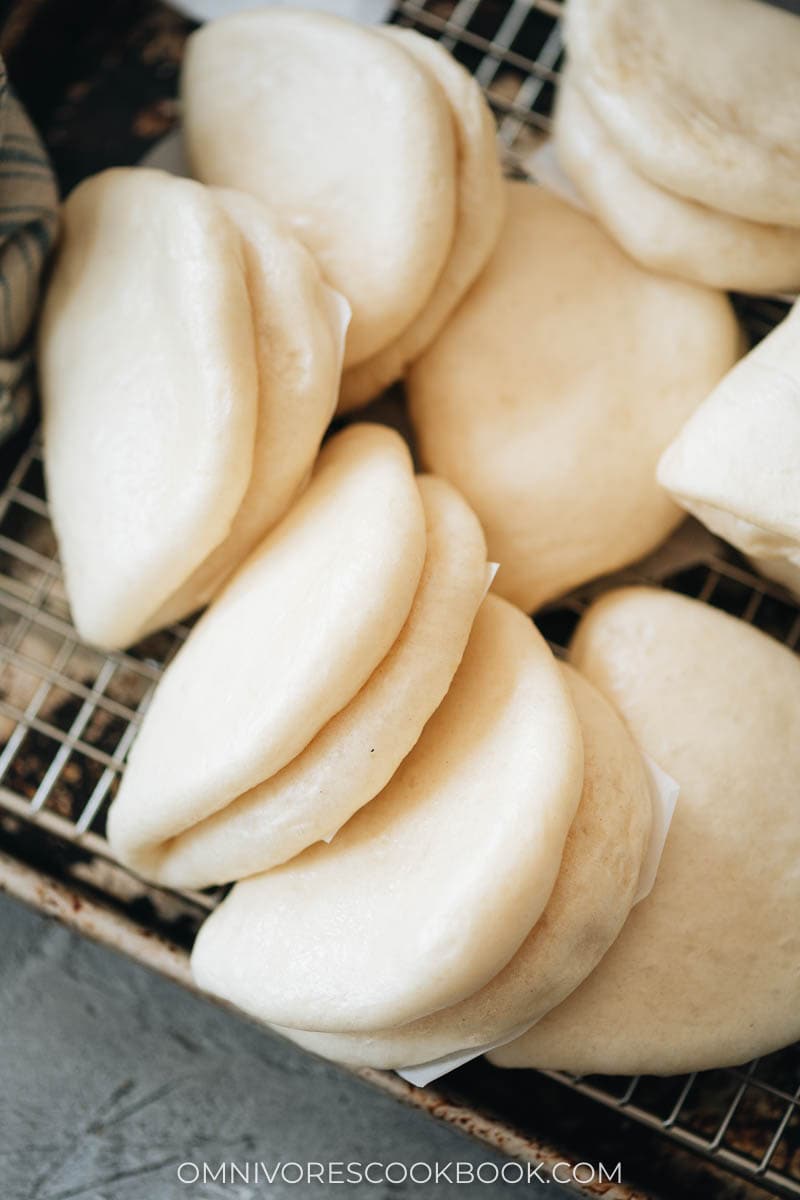
Afterthoughts
Making perfect bao buns does require a bit of patience and some practice. But the result is very rewarding.
Once you make them, you’ll find countless ways to put them to use. Turn them into sandwiches with leftover meat from dinner and fresh veggies and take them for lunch. Add some quick pickled shallots to them for more zing. Trust me, you’ll find ways to make bao buns a staple in your kitchen.
Because bao buns can be a bit of a process to make, you can (and should!) make more. They are fridge- and freezer-friendly so you can have a stash of them ready to go. Then it will be easy to enjoy bao buns whenever the craving strikes. Look for my recipe for Gua Bao to see one of the best ways to enjoy your bao buns!
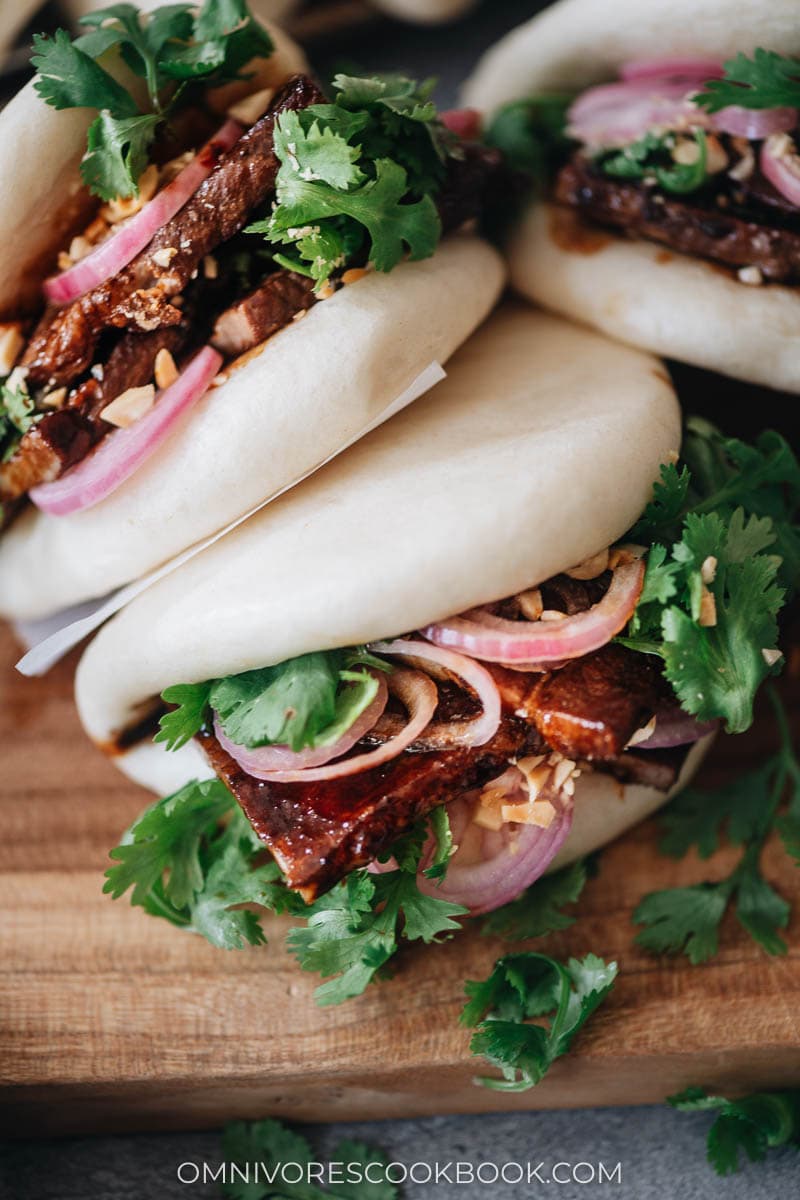
How to use bao buns
Try out these recipes below for the stuff to make fancy Asian sandwiches in your own kitchen!
- Char Siu (Chinese BBQ Pork, 叉烧肉)
- Chinese Bang Bang Chicken (棒棒鸡)
- Chinese Pickled Peppers (Quick Pickled Pao Jiao)
- Crispy Chinese Duck Breast
- Moo Shu Vegetables
- Homemade Hoisin Sauce
Want to learn more about Chinese Cooking? Sign up for my newsletter to receive the 5-Day Chinese Cooking Crash Course and recipe update!
Chinese Cooking Made Easy
Are you new to this website? This free email series is a great place to start. I’ll walk you through a few of my most popular recipes and show you how and why they work. You’ll quickly start to cook better Chinese food in your own kitchen.
Watch video
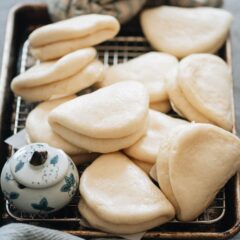
How to Make Steamed Bao Buns (Gua Bao Buns)
Ingredients
- 2 cups all-purpose flour
- 1 teaspoon instant yeast
- 1 teaspoon baking powder (double-acting)
- 2 teaspoons sugar
- 1/8 teaspoon salt
- 3/4 cup full-fat milk , cold or at room temperature
- Vegetable oil , for brushing
Instructions
Form the Dough + 1st rise
- Combine the flour, yeast, baking powder, sugar, and salt in the bowl of a stand mixer. Slowly pour in the milk while using a spoon or spatula to mix with the flour. Once the liquid is fully combined, turn on the mixer and knead for 5 minutes until it forms a firm and coarse dough ball. Alternatively, you can use your hands to knead the dough and it should take about 10 minutes.
- Cover the bowl with plastic wrap and let the dough rest for 10 minutes.
- After 10 minutes, knead the dough using your hands, for another minute, until smooth. Cover with plastic wrap. Rest the dough until it doubles in size, about 1 hour.
- While the dough is rising, prepare 10 pieces of square parchment paper about the size of your palm, to hold the buns while steaming.
- (Optional) If you’re making the gua bao filling and quick pickled shallots on the same day, prepare them during this time.
Divide the dough
- Once the dough has doubled in size, punch the dough gently with your hand to release the air bubbles. Knead for 1 minute.
- Cut the dough into 2 equal pieces, then further divide each piece into 5 smaller pieces. For a more accurate result, use a scale to measure the dough to make sure it’s 48 g per piece.
- Work on the dough pieces one at a time, forming them into balls by pinching the loose ends into the base until taut and round. Then roll the dough on the table using your hand shaped like a dome, lightly pressing the dough so it forms a round ball. Place the dough balls on a large plate and cover them with plastic wrap to prevent them from drying out.
Shape the buns & 2nd rise
- Place the dough balls pinched side down onto a clean working surface. Using a rolling pin, roll each ball into a 1/4″ (1/2 cm) thick oval that’s twice as long as it is wide (about 2.25” x 4.5”/ 5.5 cm X 11 cm). Flip the dough oval over and lightly roll again to smooth it out,
- Brush the top of the dough oval with a thin layer of oil (*Footnote 1), fold the oval in half, and place it on a piece of parchment paper you prepared earlier.
- Place the shaped buns in a steamer basket, leaving at least 1” (2.5 cm) between the buns. Cover and let rise for another 15 to 30 minutes before cooking, or until the size is 1.5 times bigger.
Cook the buns
- Right after you finish forming the first batch of buns, prepare the steamer by adding water into the base. When the buns have risen the 2nd time, add the covered steamer rack with the risen buns over the steamer. If using a metal steamer, use two layers of clean kitchen towels between the steamer rack and the lid to prevent water from dripping. Cook covered over medium heat until steam starts coming out of the pot, then turn to medium-low heat. Steam for another 10 minutes.
- After 10 minutes, turn the heat off but leave the lid on for another 5 minutes. Do not open the lid at this time! The buns might deflate without the proper resting.
- Once done, remove the buns onto a wire rack to cool. Then you can use the same steamer to cook the rest of your buns.
Workflow note
- You probably will need to cook the buns in batches depending on the size of your steamer. While you’re steaming the first batch of the buns, the second batch or the third batch might have been formed and rested. In this case, transfer the buns onto a big plate and cover them with plastic wrap. Transfer the buns into the fridge to slow down the rising. Wait until the previous batch of buns is done. Remove the rested buns from the fridge, let them return to room temperature for 2 minutes, then start steaming them. It’s important to NOT allow the buns to rise too much. If the buns are rested for too long, they will deflate once steamed.
Serve, store & reheat
- Once the buns are steamed and slightly cooled, you can use them to make gua bao, serve them with moo shu chicken, or stuff them with any braised meat.
- You can store the steamed buns in an airtight container in the fridge for up to 4 days, or in a tightly sealed ziplock bag in the freezer for up to 3 months.
- To reheat the refrigerated buns, you can place the buns on a plate and cover them with a layer of wet paper towels, then heat them up in the microwave. You can also heat the buns in a steamer, which will create a softer result.
- To reheat the frozen buns, place them directly in a steamer without thawing them and steam until fully heated through. If you want to reheat them in the microwave, you should thaw the buns first.
Notes
- The oil will prevent the buns from sticking together and can be easily separated after steaming.
Nutrition

Did you make this recipe?
I’d love to hear how it turned out for you! Please take a moment to leave a 5-star rating ⭐️ and share your thoughts in the comments further down the page. It really helps others discover the recipe too.
If you give this recipe a try, let us know! Leave a comment, rate it (once you’ve tried it), and take a picture and tag it @omnivorescookbook on Instagram! I’d love to see what you come up with.
More homemade dim sum recipes
- Baked BBQ Pork Buns (Char Siu Bao)
- Chinese Scallion Pancakes (葱油饼)
- Pineapple Buns (Bolo Bao)
- Wonton Soup
- Chinese Turnip Cake (Lo Bak Go, 萝卜糕)
Lilja Walter is a part of the Omnivore’s Cookbook team and worked closely with Maggie to develop and test this recipe.

Nurpell
I tired the recipe as written the first time and my dough didn’t rise after 1 hour. I tried it again blooming the yeast and sugar with warm milk and then adding the rest of the ingredients and it worked out great! I live in a very humid climate so maybe that was the difference. Followed the pork and pickled shallots recipe and this will 100% be made again. Thank you!!
Claudette
Made these today! Nice and fluffy. Tried one with avocado because I don’t have anything to go with it so I put them in the freezer for the time being.
Premjit
Looking like mouthwatering, i like to try
Natasha
Good day. I have an electric steamer. How long must I steam the buns for and at what temperature
C T
Good recipe but being a Chinese you should know that “Bao Buns” means “Buns Buns”. Pls help educate the world its Bao 🙏
Master master shifu shifu
I tend to say 包子 when I speak Chinese. Am I making a mistake? I know that in English we say “Bao buns” and that it’s better to translate 中国人 more directly as “Chinese person”. “A Chinese” sounds a bit antiquated and racist (but it’s one of those things where you either need to be native or an educated foreigner to understand). It would be a bit questionable for a native to talk this way. Also, since we’re educating the world, can you teach mainland Chinese people what 刈 means? And that there’s a “Y” in the word “yeast”? And English speakers how to pronounce 四川? As an aside, I don’t want to be accused of disrespecting Chinese heritage so I would like to make sure you know that I understand that 中國人 is the correct form of 中国人. Hope you understand my meaning I try express. (Looking forward to trying this recipe btw. Sorry to pollute the internet with more nonsense but I saw an opportunity for some recalibration…)
Maggie Zhu
四川 is Sichuan in Pin Yin, but not sure how to properly write the pronunciation. It’s often written as Szechuan in English, but the actually pronunciation is different.
As for刈, I think its Mandarin counterpart is 割, which means cut. I think maybe it means the bao is sliced down in the middle in this case.
Erin
Hi! Has anyone tried these with gluten free flour? If you had success what type of blend did you use?
Beth
We roasted our first duck today and I decided on a whim to make these buns as an accompaniment. So easy and delightful! Would definitely make again, look forward to playing with more filling options!
Skim
Hi, I can’t wait to try this, but do you think I can make this dairy free by using canned coconut milk instead?
Maggie Zhu
I’ve never tried it with coconut milk but I think it should be OK!